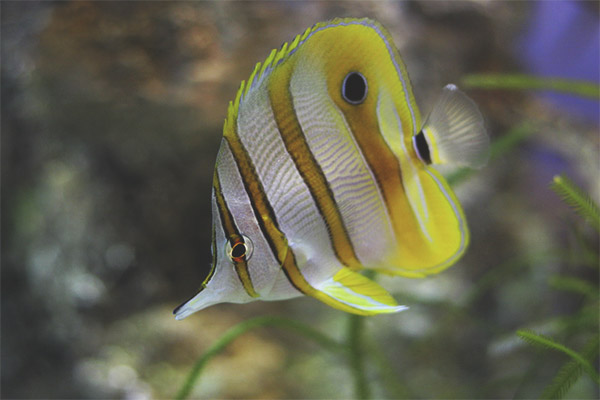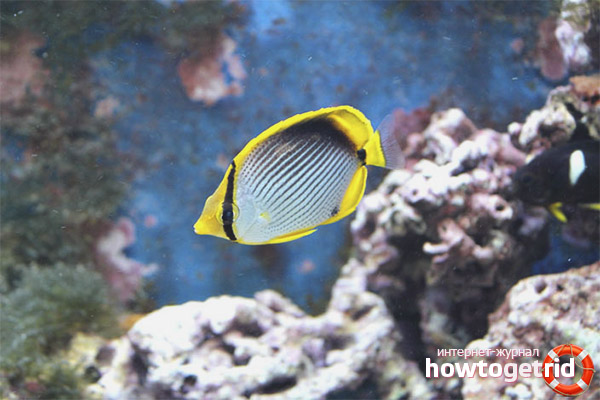The content of the article
Butterfly fishes have been nicknamed precisely because their fins resemble wings in their structure. Otherwise, representatives of the subspecies are called pantodon, they preferably live in African countries. For the first time aquarists learned about fish in the distant 1905, since then their mass study began. A pantodon is understood to mean a large individual with predator instincts, therefore it is necessary to take a careful approach to choosing a neighborhood. Interestingly, fish can hang for a long time on the surface of the water, tracking down prey. But first things first.
Description
- The fish was discovered by Peterson in 1876, since then the fish has been studied and changed characteristics. Today, most of the population is concentrated in Zaire, Cameroon and Nigeria. In western African countries, this fish is found in lakes Niger, Congo, Chad and Zambezi.
- He does not like fast flowing water sources, because he hangs on the surface for a long time and waits for his prey. If you mimic the natural biotope, you need to put floating plants in the aquarium. Fish eat fry, larvae, insects.
- If you look at the fish from above, but its fins will be similar to the wings of butterflies. In color, they are brownish with a silvery sheen and small patches. It is thanks to its peculiar fins that the fish jumps out and grabs insects infested over water.
- Under natural conditions, members of the family grow up to 13 cm in length, but aquarium pets hardly reach 10 cm. As for the duration of existence, fish live for 5 years.
- Oral cavity is large, it helps them to collect food from the surface of the water and catch insects in flight. The fins provide a high and clear jump, therefore, when maintained in an aquarium environment, it is necessary to cover the reservoir with a lid.
- For representatives of this family it is considered quite normal “fading” in anticipation of production. The unique features include the presence of a swim bladder, allowing pets to breathe atmospheric oxygen and maintain balance.
Content
- It is necessary to provide fish with an aquarium with the calculation of 150 l. for a couple. It is important to take into account the depth of the water space, which should not be above 30 cm. That is, choose a spacious tank with enough space for swimming in width and length.
- Fish will always prefer stagnant water, so limit yourself to installing a calm filter that performs its main task - water purification.
- Pantodons do not like the depth, but they are not tempted to be in crampedness either. From the professionals one can hear that the fish feel best, living separately. That is, one individual has 1 tank of water.
- Representatives of this species love acidified water with a pH balance of 6-7 units. As for stiffness, its optimal performance is 8-12 units, and the temperature regime - 25-28 units.
- It is important that the lamps be scattering, because the brightness of the fish will hide and rarely appear to you. Take care of floating plants, casting a shadow. The fish will hide under them.
- Again, these fish are not suitable for inexperienced people.When the pet is frightened, it will easily jump out of the water. It is also difficult to tolerate fluctuations in the characteristics of water, demanding nutrition. Fish eat only live food or insects, often refuse from dry ones.
Feeding
- Considered representatives of fish belong to insectivorous individuals. Therefore, feeding in pantodon aquarium conditions is recommended exclusively for live food.
- Try to give the fish crickets, worms, larvae, fry, spiders, flies and shrimp. Consider that the individuals in question are fed exclusively from the surface of the water. They will not sink to the bottom in search of food.
Compatibility
- Breeders strongly recommend keeping the species in question in a separate aquarium. The problem is that pantodon need quite unusual conditions of detention. But do not be upset ahead of time. Such individuals get along well with other fish.
- The main thing is that in one aquarium there are no fry. Pantodons will endlessly hunt for small fish. Anything less than a pantodon is considered a potential food for them.Also presented individuals live exclusively in the upper part of the aquarium.
- Who will live on the bottom, they care little. The only thing worth noting is that breeders do not recommend keeping similar species in the same aquarium. Otherwise there will be constant skirmishes and aggression. Pantodons do not get along with Sumatran barbs, individuals constantly fight.
Differences between female and male
- To learn to distinguish between individuals, it is necessary to pay attention to the anal fin. The male can see longer rays, between which there will be a deep cut.
- As for females of pantodon, the anal fin in such individuals has a rounded and even shape. Also, males are noticeably smaller in size.
Breeding
- Breeding in aquarium conditions causes a number of difficulties. Therefore, the process is practically impossible. Individuals reach sexual maturity at 1.5 years, sometimes earlier. If you still want to try breeding, it is necessary to stimulate spawning.
- To do this over the course of 20 days, gradually reduce the amount of water to 10-12 cm.The temperature in the aquarium should be about 30 degrees. After the mating season, the female begins to spawn. Eggs will float to the surface. As soon as they darken, catch them and put them in another aquarium. Fry appear in 2 weeks.
Experts advise against keeping these fish for people who do not have this experience. Yet more butterflies are suitable for professionals who have been in the aquarist's field for quite some time.
Video: aquarium butterfly fish












To send